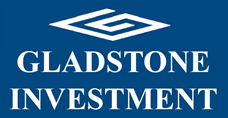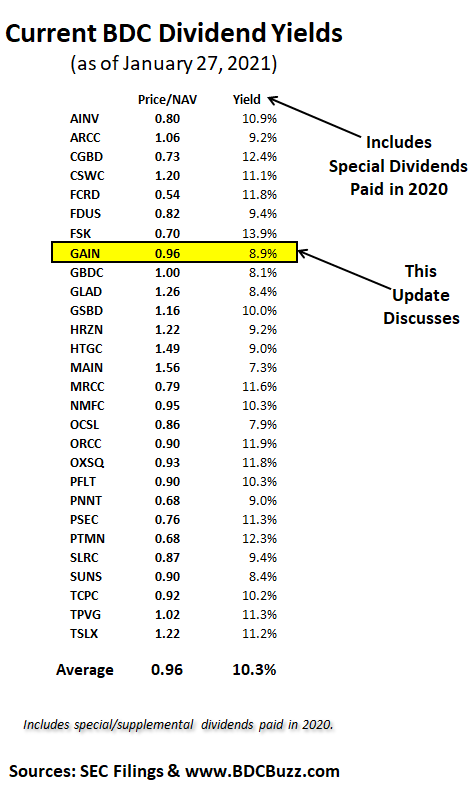
GAIN Dividend Coverage Update
GAIN has recently announced two transactions accounting for $43.8 million of portfolio investments or 7.3% of the overall portfolio fair value which will result in significant realized gains and additional income. Around $34.3 million was invested in non-income-producing equity positions potentially driving ~$0.76 per share of realized gains (if exited at recent fair values) and will likely be reinvested mostly into income-producing assets.
On January 4, 2021, GAIN announced the exit of its investment in Frontier Packaging, Inc. resulting in the repayment of its $9.5 million debt investment at par and “realized a significant gain on its equity investment”. Its equity investment in Frontier was valued at $13.4 million as of September 30, 2020, and if exited at the same value would result in realized gains of around $0.36 per share. Also, the proceeds will likely be reinvested into income-producing assets.
“With our sale of Frontier Packaging and from our inception in 2005, Gladstone Investment has exited over 20 of its management supported buy-outs, generating significant net realized gains on these investments in the aggregate. Our strategy as a buyout fund, realizing gains on equity, while also generating strong current income during the investment period from debt investments alongside our equity investments, provides meaningful value to our shareholders through stock appreciation and dividend growth. Significant winners like Frontier prove out our focus on buying high quality businesses, backing outstanding management teams and being able to have investments with long hold periods.”
On December 21, 2020, GAIN announced the recapitalization of its portfolio company Old World Christmas, Inc. with the origination of a new secured term loan. GAIN received “significant equity proceeds and realized a capital gain and other income”. Its equity investment in Old World was valued at $20.9 million as of September 30, 2020, and if exited at the same value would result in realized gains of around $0.40 per share.

GAIN will not be covering its upcoming dividends due to remaining underleveraged, additional non-accruals, lower portfolio yield, and continued lower dividend income. However, dividend coverage should improve due to th recent increase in portfolio yield, higher use of leverage, and likely lower non-accruals.
Also, the upcoming realized gains will more than cover its $0.07 per share monthly dividend as the company reinvests the proceeds.
Also, as of September 30, 2020, GAIN had around $5 million or $0.16 per share of undistributed income “available for distribution to shareholders in future periods”:
“In addition, distributable income to shareholders remained solid. On a book basis undistributed net investment income combined with net realized gains totaled over $5 million or about $0.16 per common share. This amount is reduced by the book accrual of the capital gains based incentive fee that’s required under U.S. GAAP and that number is roughly $7 million which is not contractually due yet. All else equal, the $0.16 per common share would be available for distribution to shareholders in future periods even if the entire capital gains-based incentive fee accrual were to be contractually due which it is not.”
Similar to BDCs such as MAIN and CSWC, the company supports supplemental/semiannual dividends through realized gains typically from equity positions:


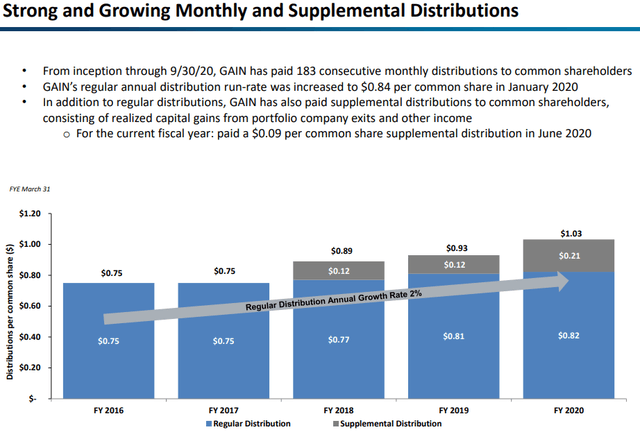
GAIN has increased its dividend three times over the last two years while growing its NAV per share by 7.5% over the last three years. Also, GAIN has relatively low amounts of leverage with the potential for improved coverage through portfolio growth and rotating out of equity investments. On October 13, 2020, GAIN reaffirmed its monthly dividend of $0.07 per share.

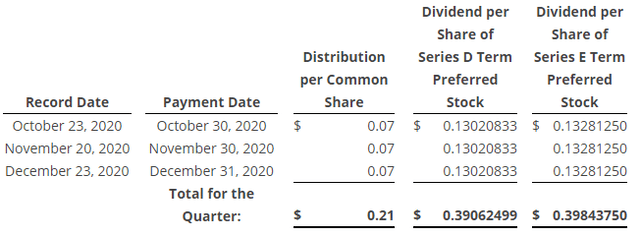
Previously, the Board approved the modified asset coverage ratio from 200% to 150%, effective April 10, 2019. However, the company is subject to a minimum asset coverage requirement of 200% with respect to its Series D Term Preferred Stock.
The amount of preferred/common equity accounted for around 25% of the portfolio fair value which is being monetized and eventually reinvested into income-producing secured debt.

Full BDC Reports
This information was previously made available to subscribers of Premium BDC Reports, along with:
- GAIN target prices and buying points
- GAIN risk profile, potential credit issues, and overall rankings
- GAIN dividend coverage projections and worst-case scenarios
- Real-time changes to my personal portfolio
BDCs trade within a wide range of multiples driving higher and lower yields mostly related to portfolio credit quality and dividend coverage potential (not necessarily historical coverage). This means investors need to do their due diligence before buying.
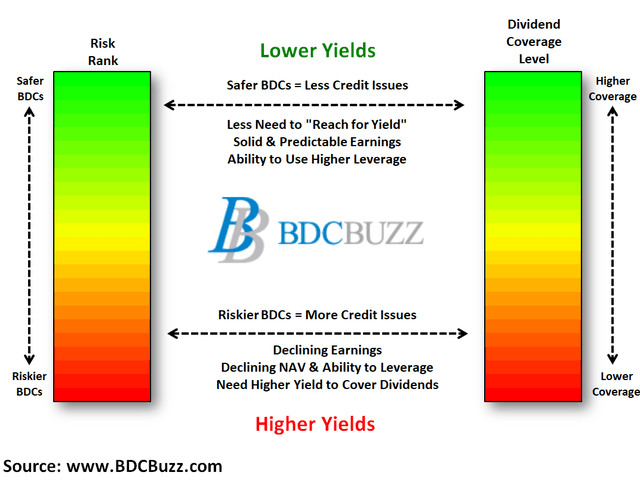
To be a successful BDC investor:
- Identify BDCs that fit your risk profile.
- Establish appropriate price targets based on relative risk and returns (mostly from regular and potential special dividends).
- As companies report results, closely monitor dividend coverage potential and portfolio credit quality.
- Diversify your BDC portfolio with at least five companies. There are around 45 publicly traded BDCs; please be selective.

